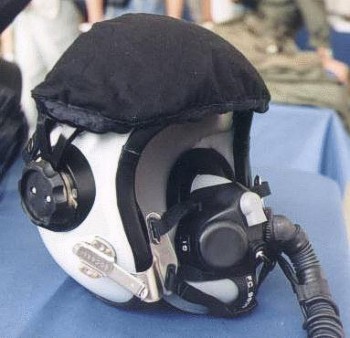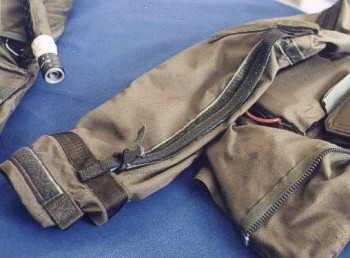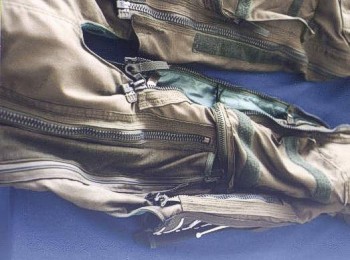|
It
should be noted that the Swedish suit -- in 1990 designated VGI/4,
for "Ventilerad G-dräkt och Isolerdräkt" =
Ventilated G-suit and Immersion suit -- isn't just a G-suit, but
rather a "tactical flight combat suit", as it fulfills
other requirements too.

Overview
The Swedish Tactical Flight Combat Suit has been developed by
FMV (The Swedish Defence Material Administration) and is mainly
made by Swedish companies.
The requirements for the TFCS are:
· 9 G sustained with high onset rate, at least 30 s after 6 G/s
and at least 7 G after a gradual (0.1 G/s) onset without anti-G
straining manoeuvre
· Biological and chemical warfare protection
· High altitude protection, including explosive decompression
· Arctic climate and cold water survival
· High temperatures (fire) protection both in cockpit and on
the ground
· Air blast protection for ejection speeds up to 600 kt
· Thermal protection
Development
started in 1985, with the main goal being improved G protection.
Two versions were developed, with one selected for production in
1997. The choosen version gives the pilot the option of choosing
either a ventilated immersion suit, for use when the water
temperature is colder than 12 degC, or a flight suit with the
Full Coverage Anti-G Suit being a separate garment. (The version
not selected consisted of an air ventilated immersion suit with
integrated FCAGC.)

Its
main parts are:
· Underwear both for hot and arctic climates
· Boots with connectors for the leg restraints
· Immersion suit, made of Ventile L28/L32 (tightly woven
cotton)
· Flight suit, made of Nomex Delta C 220g/m2
· Full coverage anti-G suit, made of Nomex Delta T/A 200g/m2
· Flight jacket with chest bladder, automatically in water
deploying life preserver, emergency beacon and connectors for
the arm restraint system, made of Nomex Delta T/A 200g/m2
· Helmet with oxygen mask with pressure breathing for
G-protection
· Biological and chemical protection system
The flight jacket is designed by Saab, and is made together with
the FCAGS, the flight suit and immersion suit by AB GERMA.
Helmet
FFV type 116
The helmet which is made of kevlar weighs less than 1.3 kg,
slightly depending on size, compared with 3 kg for the previous
generation. It has a tensioning bladder, dual polycarbonate
visors (one tinted). The flight helmet, FFV 116, is designed and
made by FFV Aerotech. Fitting the helmet individually for a
pilot usually takes between 30 min and 2 hours. Included in the
fitting is the shaping of the two visors, one clear and one
tinted, to fit snugly over the mask. The black cloth visor
protector is usually left on the helmet when flying, on the back
of the head. Like previous Swedish helmets it lacks the chin
strap.

An
high altitude/low profile pressure breathing oxygen mask is
used. This is the Swedish version of the Gentex HA/LP mask, with
anti-suffocation valve and dual microphones.
Flight jacket
The flight jacket is integrated with the life preserver and has
connectors for the the arm restraining system, as well as
pockets for an emergeny beacon and other survival equipment.

This photo shows a detail of the arm restraining device. The
metal fastener, which is connected to a strap on the ejection
seat, is normally at the height of the elbow, kept there by a
velcro tab. On ejection, it's pulled free and down towards the
wrist, sliding down under a strap also fastened along its length
by velcro to the sleeve.
Full Coverage Anti-G Suit
The trouser and jacket are both worn over a regular looking
flight suit which has no pockets.
On the rear side, the white lacing used to tighten the trousers
to fit the pilot. It is covered by a zipper. Above that, on the
thigh, is a zipper to be unzipped on the ground, to make them
more comfortable to walk in. On the inside of the legs are the
snap fasteners and heavy duty zipper to put them on or take the
trousers off.

Previous
types of G suits had up to 9 air bladders. This type consists of
a single large bladder, making them more comfortable.
Boots
The boots have one set of lacing to fit them to a pilot, and one
on the lower part, the upper is normally closed by a zipper. The
boots are high and have a cloth pocket on the outside.
Biological
and chemical protection
As of 1998 testing of the system is still in progress. FFV
Aerotech is developing the system.
Requirements for the system:
· not affect the general flight safety and survival
requirements
· not restrict the aircraft operational limits
· be acceptable to the pilots as regards donning, doffing, heat
stress and comfort
· have a rip off visor to be used in case of emergency
· have drinking facility
· be spectacle compatible
It consists of a chloroprene front piece with a polycarbonate
visor and Gentex HA/LP-PPB mask connected to a C-protection
textile collar. The front piece and collar are attached to the
outside of the helmet. The visor is continuously demisted by
filtered air from with breathing oxygen as a backup, from two
nozzles.
Images are taken from the
SAAB website. Text and photo’s from Urban
Frederiksson’s website |